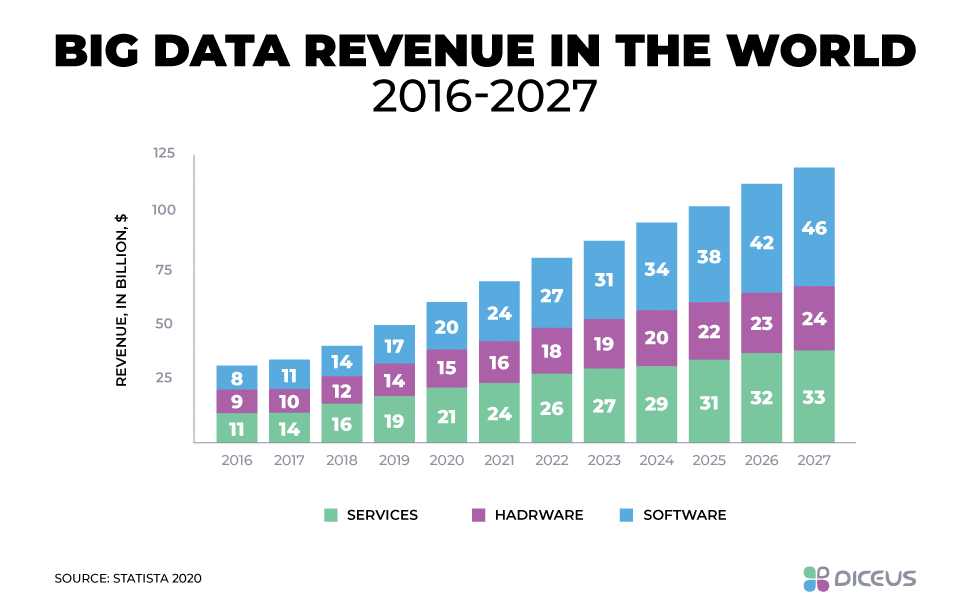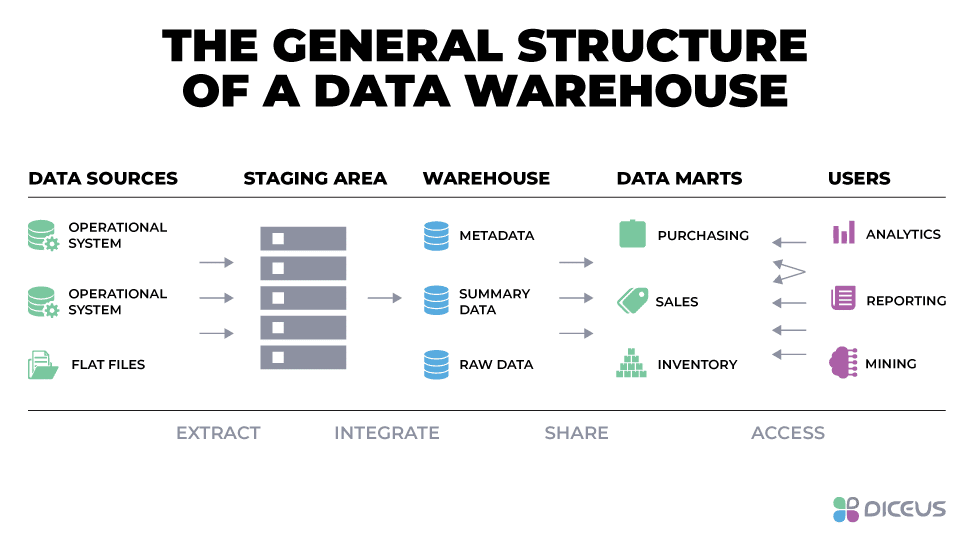

Best DWH (data warehouse) solutions on the market and why you may need them
What’s the size of the global datasphere? IDC reports that in 2019, it was around 40 zettabytes. It’s projected that the sector will increase to 175 zettabytes in 2025. In terms of time, if one person wanted to download the entire package in 2025, he/she would have to spend 1.8 billion years! Data revenue will rise, as will the demand for data warehouse solutions.

Undoubtedly, to deal with Big Data and scale properly, businesses require the appropriate tools. It’s essential not to use a sledgehammer to crack a nut. In other words, you should understand your business goals and build the software that matches these needs perfectly. At DICEUS, we design and implement custom systems tailored for each client exclusively.
Overall, data warehouse solutions remain the universal tools for data management/analysis, so we’re going to talk about them today. The guide unveils the basics of DWH concepts, the purpose of this software, and its pros and cons. It also provides a review of data warehouse vendors that deliver off-the-shelf and custom products.
DWH systems 101
In the beginning, let’s understand what are databases and data warehouses, how they work, which architectures exist, and what are other approaches to data processing. The section may look a bit complicated, but give it a chance. These are the very basics described in simple words. After studying this section, you will understand DWH better and will be able to spot the best warehouse solutions.
What is a data warehouse?
The simplest definition of data warehouses sounds like “software systems for data analysis and reporting”. These apps are repositories that contain all business information. They are cores of business intelligence departments thanks to rich functionality in the area of reports and analytics. Warehouses keep the integrated data from various sources, both current and historical.
At this point, let’s find out the difference between a database and a DWH. Even experienced business people confuse these terms often. Here’s the main contrast:
- Databases or OLTP systems. Contain normalized data for better durability and atomicity. It’s more complicated to create queries for databases. Instead, they work best when a brand needs to record information quickly and store it.
- Data warehouses or OLAP systems. Contain de-normalized data that facilitates aggregation and analysis. Respectively, companies not only store information but can get precise insights and generate reports by using DWH apps.
It’s clear that DWH apps are highly useful. But what is the primary purpose of a data warehouse? Well, the function is to extract, transform, and load (the approach is known as ETL) information. The goal is to gather the essential data under one roof, get market insights, and improve business processes, eventually.
How do data warehouses work?

The ETL model is the basis of data warehouse solutions. Information in them follows the same path in the majority of cases. Initially, a tool receives data from various sources like CRM apps or social media. Then, a DWH integrates and cleans info to make it ready for analysis. After integration, the primary module stores data and delivers it to users, who can then mine it, create queries, and send it to other systems.
Based on the process, Renson Obongo, BI consultant at Analytics8, defines four core elements and steps in any DWH:
- Staging areas for gathering. Collect unstructured data from sources – operational bases. Usually, there’s one staging layer for each source.
- Integration/cleansing areas for processing. Combine packages from staging areas, apply business logic rules and integration. Data here is stored temporarily.
- Databases for storing. Keep de-normalized information received from integration parts. Reporting/analyzing opportunities become wider at this stage.
- Access areas for sharing. It’s not a pure layer but a way to represent data-consuming options like SQL, reports, and automated exchanges. Data marts exist here.
As for the difference between structures, there are basic warehouses that support simple queries and more advanced tools with staging and data mart layers. Here, staging areas improve integration accuracy and cleanse information better. Data marts help deliver the needed information to target user groups. In this case, the difference between a data warehouse and a data mart is simple: the latter is just a structural part of the former.
Now, we have a complete data warehouse meaning. It’s a system that gathers, transforms, and stores data and metadata, organizes it and enables analytical opportunities.
Learn more about an effective data migration strategy.
Are there any alternatives?
Yes. Apart from traditional SQL data warehouse programs, there are other approaches to data management. It happens that even the best data warehouse vendors can’t provide a product that deals with all the modern challenges. With the rise of new data types from IoT devices, video hustings, audio units, new challenges arise. Big Data changes the world. Regulators reveal new standards. Privacy becomes even more essential.
With all these updates, it seems a good idea to consider alternative data processing options. Here are the most prominent ones:
- Data lakes. Generally, a data lake is all the info your brand has. Most often, it’s unstructured and raw. When comparing a data warehouse to a data lake, the latter is better for machine learning and AI systems. It’s also more flexible because it lacks strict rules – users can change queries and interaction models on the go.
- No SQL data warehouses. Historically, SQL or relational systems with traditional data structures were the most popular. Today, alternatives feature flexible models that are more scalable and suitable for Big Data. The examples are key-value bases (Redis), documents (MongoDB), wide columns (Hadoop), and graphs (New4J).
- Self-service BI modules. Unlike traditional tools that automate reporting, self-service alternatives pass this task to users. As a result, employees get the freedom to access and process data without software limits. Self-service BI tools are convenient for fast-growing teams that need to scale quickly.
If you want to develop the best warehouse solutions or upgrade the existing ones, look at innovations. The mentioned alternatives may be better than traditional DWH tools for some businesses. We can help you analyze your company goals and issues to define the most suitable software type. But if you’ve decided to deploy a DWH, don’t forget about data warehouse solutions comparison, including one for pros and cons.
Of course, don’t forget about the reliability of data warehouse solutions. You can find more on this topic in our article dedicated to DWH security.
Data warehouse advantages and disadvantages
As with any digital tool, a DWH isn’t a magic wand. It can’t save your company from all failures or prevent issues with the software, hardware, customers, and regulators. However, it can optimize the majority of processes. Further, we want to compare critical benefits and drawbacks. Note that the next sections are dedicated to traditional DWH structures. The analysis of data warehouse advantages is provided by Daan van Beek, owner of Passionned Group.
For
- Advanced reporting. Users can quickly switch between various filters and indicators, compare results, and generate comprehensive reports under one roof.
- Fast responses. Thanks to optimization, it’s easy to get the required info and deliver to any department or address end-users’ requests.
- High quality of data. Before moving to the central database, information is checked and cleansed. That’s why DWH systems store quality data.
- Historical information. Warehouses help to access historical data, including all changes and previous values. It becomes possible to perform more precise analyses.
- Integrated data. Data warehouse vendors create tools that gather internal and external info. It’s stored in one place and features clear structures.
- Optimized search. Apart from analysis and dashboards, DWH solutions also help to find the needed information quickly.
Against
- Compatibly issues. For businesses with legacy software, it may be tricky to deploy a new system. Experienced digital transformation partners can help here.
- High launch/maintenance costs. It’s an essential point to consider. DWH tools are often expensive, so you should know whether you really need them.
- New user needs. After the launch, employees can realize the benefits and start generating more queries. Reports may become more complicated, too.
- Rigid standards. Due to the structuration of data, its flexibility reduces. This may limit usage for non-standard tasks, slow down queries, etc.
- Security concerns. When you have core information in one place, this place must be 100% protected. Otherwise, breaches and data leaks are possible.

The best moment to get DWH software
Ultimately, the perfect switching periods are different for different companies. But there’s one sign that can help you to identify this moment. While most companies start with basic data management tools like Excel or Google Spreadsheets, they may face performance problems. Due to limitations of the software, programs/sheets start loading slower, data start missing, and employees start complaining. Departments also may want to make data shareable to generate better insights or optimize processes.
Also, here are three questions that will help you learn if you need a new tool:
- Do you have data coming from different sources? If yes, consider getting a DWH app to integrate all points and enable automated ETL processes.
- Do you have performance issues during reporting? If yes, move away from reports based on real-time operational bases and switch to a single warehouse.
- Do you have several sources of truth? If yes, and if you face data inconsistency across departments, it’s time for an SSOT for the whole business.
It may be tough to choose the correct structure and implementation model. Different companies require different tools. For instance, SMEs are often happy with basic apps, while multinational corporations require dozens of staging layers and data marts. We handle custom development by making unique products with the needed features only. With tailored software, you can avoid the majority of the mentioned disadvantages.
To learn more about our expertise in DWH design/integration, feel free to check the case – the best data warehouse system for a large bank.
Out-of-the-box data warehouse solutions comparison
Moving to the examples, let’s check which DWH systems are considered the best. We will analyze them by functions, advantages/drawbacks, prices, client focuses, and platforms. Note that this section features only off-the-shelf or prepackaged software that supports little to no customization. For custom products from Diceus, check the last paragraph.
Also, be aware that the selection is mostly based on Gartner’s magic quadrant methodology for data management. We will look at the market leaders and one visionary—a company with a strong market vision but not as good implementation. The recent report does not include challengers, and we don’t want to focus on niche players.
Amazon Redshift
Redshift is part of the famous cloud system Amazon Web Services, enabling plentiful online data analysis opportunities. It utilizes standard architecture and SQL tools that support various data types. The system relies on high-performance hardware, re-replicates information automatically, and offers the Spectrum tool to analyze data in Amazon S3 directly. Still, it features a relatively slow query planner and high hourly costs for idle times.
- Platform: Amazon Web Services, SaaS.
- Pricing:
- General – time-based, from $0.25 to $13.04 per hour.
- Spectrum – size-based, $5 per TB.
- Segment: small, mid, and large enterprises.
- Type: MPP, columnar storage.
Explore DICEUS finance data warehouse development services
Google BigQuery
BigQuery is a native system developed by Google and based on its cloud platform. It’s a serverless DWH solution with SQL support and automated data processing. It also supports connected apps like Hadoop and Spark. The tool is pretty fast on small and medium scales but may become slower and slower as the size increases. As for efficiency, the software will be much cheaper for teams with workload spikes. BigQuery requires some coding skills.
- Platform: Google Cloud, SaaS.
- Pricing:
- Storage – size-based, from $0.01 to $0.02 per GB.
- Querying – pay-as-you-go, $5 per TB.
- Subscription – flat-rate, from $10,000 per month.
- Storage – size-based, from $0.01 to $0.02 per GB.
- Querying – pay-as-you-go, $5 per TB.
- Subscription – flat-rate, from $10,000 per month.
- Segment: small, mid, and large enterprises.
- Type: Dremel, columnar storage.
You might be interested in reading our latest article “Key steps to building a data warehouse”
IBM Db2
Instead of a single product, IBM offers a family of different data warehouse solutions – Db2. They’re based on the AI features, comprehensive processing, scaling, and universal deployment options. You can choose a cloud or a local tool, get an integrated system, or extend the capabilities with IBM InfoSphere DataStage – a BI and DWH module focused on data integration. It features the combined HDW/LDW architecture and Hadoop.
- Platform: cloud and on-premises products.
- Pricing: custom quote, contact a vendor to reveal.
- Segment: small, mid, and large enterprises.
- Type: SMP/MPP, relational/non-relational/object-relational, columnar storage.
MarkLogic data hub platform
This one is the only visionary from the Gartner’s magic quadrant. MarkLogic offers a comprehensive, unified system to manage enterprise data. It handles integration, search, analysis, curation, storing, and access tasks. The main product is available as a fully-managed software and as self-service tools. MarkLogic also supports integration with leading cloud systems like Azure and AWS.
- Platform: SaaS, on-premises, and hybrid deployment.
- Pricing
(fully-managed option):
- Storage – size- and time-based, $0.1 per GB per month.
- Computing – time-based, $0.125 per MCU per hour.
- Segment: small, mid, and large enterprises.
- Type: distributed, multi-model, NoSQL.
Microsoft Azure Synapse analytics
Azure Synapse is a new name for the popular MS SQL DW product. The platform is available in the native cloud, with several performance levels. For instance, Gen2 available for large data sets is one of the fastest architectures. Azure helps to manage data and handle Big Data analyses. It can migrate your databases, provide valuable machine intelligence-based insights, and scale without limits. The price is pretty high, however.
- Platform: Microsoft Azure, SaaS.
- Pricing:
- Storage – size- and time-based, $233.47 per TB per month.
- Gen1 – pay-as-you-go, from $1.21 to $145.164 per hour.
- Gen2 – pay-as-you-go, from $1.2 to $725.82 per hour, savings available.
- Segment: large enterprises, mostly.
- Type: relational, node-based.
Oracle autonomous data warehouse
Developed and hosted by Oracle, this cloud DWH is user-friendly, relatively fast, and elastic as it automates a lot of processes and scales. The tool supports apps and clusters, works with different operating systems, and has virtualization features. As well, this particular tool is compatible with other Oracle data warehouse solutions, including local ones. It’s easy to connect them to reach even better data integration.
- Platform: Oracle, SaaS.
- Pricing:
- Storage – size- and time-based, $222 per TB per month.
- Computing – pay-as-you-go, $2.52 per OCPU per hour.
- BYOL – pay-as-you-go, $0.48 per OCPU per hour.
- Segment: large enterprises, mostly.
- Type: Exadata, parallel, columnar storage.
SAP HANA
It’s a universal management suite from SAP. The solution works as a database that stores and gathers info, but it also can analyze data and complete ETL tasks. It can be integrated with different cloud systems like AWS and Google, and also can work with local software. Thanks to the modular structure, HANA features a simple deployment and tuning. It’s also known for intelligence with high scalability.
- Platform: SaaS and on-premises deployment.
- Pricing:
- AWS storage – size- and time-based, from $0.2 to $0.28 per GB per month.
- AWS work – pay-as-you-go, from $0.98 to $4.44 per 2 blocks per hour.
- Google storage – size- and time-based, $0.2 per GB per month.
- Google work – pay-as-you-go, from $0.98 to $2.6 per 2 blocks per hour.
- SAP work – subscription, from $1,600 to $35,571 per tenant per month.
- Azure work – subscription, from $6,225 to $56,778 per tenant per month.
- Segment: mid and large enterprises.
- Type: multi-model, in-memory, columnar storage.
More about data warehouse for banking
Snowflake
Snowflake represents an innovative approach to data management. It’s a SaaS-only, Agile, intelligent, and secure. It combines all the workloads under one roof, making it easy to manage data flows. What’s even better, the system features near-zero maintenance efforts. Snowflake is one of the fastest and cheapest popular DWH software tools on the market. Moreover, it’s compatible with the leading cloud platforms.
- Platform: native engine, SaaS.
- Pricing:
- Storage – size- and time-based, from $40 to $46 per TB per month.
- General – subscription and time-based, from $2 to $5.7 per hour.
- Segment: all sizes of businesses.
- Type: shared-disk/shared-nothing, MPP, columnar storage.
Teradata Vantage
Previously known as Teradata DWH, Vantage is a DWH tool for big data packages. It gathers, processes, and analyzes the information using next-gen intelligence features. Teradata has convenient integrations with various cloud and local services, languages, and engines. It’s highly scalable, features rich functionality, and has friendly interfaces, but installation may be expensive and time-consuming.
- Platform: native cloud, third-party cloud, customer cloud, customer hardware.
- Pricing: custom quote, contact a vendor to reveal.
- Segment: mid and large enterprises.
- Type: SQL, MPP, VPrcos.
You might be interested in learning more about master data management in banking
Top-rated custom DWH tools from DICEUS
If you’re interested in tailored customizable products instead of premade programs, it’s better to look at tech partnership opportunities. Custom tools are preferable to ready alternatives because they balance costs and features perfectly. You can get precisely what you need without overpaying or underperforming.
DICEUS acts as a digital transformation partner. We deliver the best warehouse solutions because we always know what customers want. The cooperation process begins with consolations and business analysis, then we run POC projects, design MVP prototypes, deploy the final product, train employees, and provide for lifelong maintenance. All in one!





